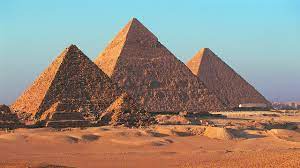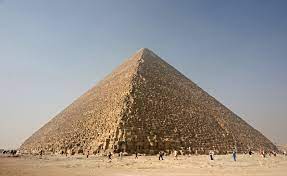The Great Pyramid of Giza, also known as the Pyramid of Khufu or the Pyramid of Cheops, is one of the most iconic and enduring symbols of ancient Egypt. Located on the Giza Plateau, just outside Cairo, Egypt, it is the largest and oldest of the three pyramids
in the Giza pyramid complex and one of the Seven Wonders of the Ancient World.
A Monumental Achievement
Constructed over approximately 20 years during the reign of Pharaoh Khufu (Cheops) in the 26th century BCE, the Great Pyramid
stands as a testament to the ingenuity, engineering prowess, and architectural mastery of the ancient Egyptians. Built using
millions of limestone blocks, each weighing several tons, the pyramid originally rose to a height of around 146 meters (481 feet), making it the tallest man-made structure in the world for over 3,800 years.
The Great Pyramid of Giza renowned for its remarkable architectural precision, with each stone meticulously cut and placed to create a seamless outer surface. The precision of the pyramid’s construction is evident in the alignment of its corners with the cardinal
points of the compass, as well as the level of its base. Despite being constructed over 4,500 years ago, the pyramid’s geometric accuracy continues to astonish engineers and architects today.
Find out what is inside pyramid: https://www.britannica.com/video/202080/more-Great-Pyramid-of-Khufu-Egypt-Giza
Architectural Marvel
The Great Pyramid is a marvel of precision engineering and mathematical sophistication. The four sides are aligns almost perfectly
with the cardinal points of the compass, and its base forms a near-perfect square, a remarkable feat of geometric precision considering
the immense scale of the structure. The pyramid’s interior features a complex network of chambers and passageways, including the King’s Chamber and the Grand Gallery, which continue to fascinate archaeologists and historians to this day.
The methods used to construct the Great Pyramid remain a subject of debate among scholars and researchers. While the exact
techniques employed by the ancient Egyptians are not fully understood, various theories have been proposed. Including the use of ramps, levers, and sledges to transport and position the massive limestone blocks. Recent archaeological discoveries, such as the
remains of a ramp system near the pyramid, provide valuable insights into the construction process but also raise new questions about its complexity.
Mysteries and Legends
Moreover despite centuries of study and exploration, the Great Pyramid continues to be shrouded in mystery and intrigue. From the
enigmatic purpose of its construction to the methods used to build it, numerous theories and hypotheses have been proposed,
ranging from the practical to the fantastical. However Some believe that the pyramid served as a tomb for Pharaoh Khufu, while others
speculate that it was an astronomical observatory or a repository of ancient wisdom. Theories about its construction techniques,
including the role of ramps and the use of advanced mathematics, continue to fuel debate among scholars and enthusiasts alike.
The Great Pyramid of Giza has left an indelible mark on human history and culture, inspiring awe and fascination for millennia.
Its enduring legacy can be seen in the countless works of art, literature, and popular culture that reference or depict the pyramid, as well as in the ongoing scientific and archaeological research dedicated to unraveling its mysteries.
As one of the last surviving wonders of the ancient world, the Great Pyramid continues to capture the imagination of people
around the globe, serving as a testament to the ingenuity and creativity of the human spirit. Beyond its architectural significance,
the Great Pyramid holds immense cultural and historical importance as a symbol of ancient Egyptian civilization.
For millennia, it has captured the imagination of people around the world, inspiring awe and wonder with its grandeur and mystery.
Today, it remains a powerful symbol of human ambition, perseverance, and achievement, a testament to the enduring legacy of one of the world’s greatest civilizations.
Preservation and Legacy
Preserving the Great Pyramid and ensuring its legacy for future generations is a paramount concern for Egyptian authorities and
the global community. Efforts to conserve the pyramid and the surrounding Giza necropolis are ongoing, with measures in place to protect the structure from natural and human-induced threats.
Through archaeological research, education initiatives, responsible tourism practices, efforts is made to safeguard this extraordinary monument and ensure that it continues to inspire awe and wonder for centuries to come.
In recognition of its outstanding universal value, the Great Pyramid of Giza, along with the other pyramids of the Giza necropolis
The Sphinx, designated a UNESCO World Heritage Site in 1979. This prestigious designation underscores the pyramid’s
importance as a cultural treasure of humanity and highlights the need for international cooperation in its preservation and management.
By safeguarding the Great Pyramid for future generations, we can ensure that its legacy continues to inspire wonder and curiosity for centuries to come.

The Great Pyramid of Giza stands as a timeless symbol of human ambition, ingenuity, and achievement, a testament to the
enduring legacy of ancient Egypt. From its monumental scale to its enigmatic mysteries, it continues to captivate the imagination
and inspire wonder, reminding us of the remarkable feats that humanity is capable of achieving. As we marvel at its
grandeur and contemplate its secrets, the Great Pyramid invites us to ponder the mysteries of the past and the enduring
legacy of one of the world’s greatest civilizations.
Read More: https://placesandlifestyle.com/amazing-structures-in-antarctica/




